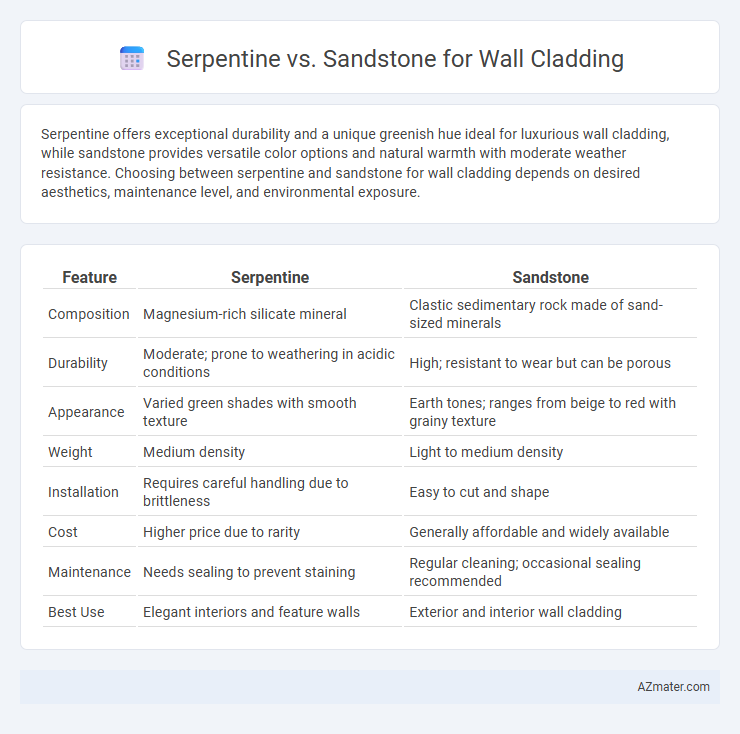Serpentine offers exceptional durability and a unique greenish hue ideal for luxurious wall cladding, while sandstone provides versatile color options and natural warmth with moderate weather resistance. Choosing between serpentine and sandstone for wall cladding depends on desired aesthetics, maintenance level, and environmental exposure.
Table of Comparison
| Feature | Serpentine | Sandstone |
|---|---|---|
| Composition | Magnesium-rich silicate mineral | Clastic sedimentary rock made of sand-sized minerals |
| Durability | Moderate; prone to weathering in acidic conditions | High; resistant to wear but can be porous |
| Appearance | Varied green shades with smooth texture | Earth tones; ranges from beige to red with grainy texture |
| Weight | Medium density | Light to medium density |
| Installation | Requires careful handling due to brittleness | Easy to cut and shape |
| Cost | Higher price due to rarity | Generally affordable and widely available |
| Maintenance | Needs sealing to prevent staining | Regular cleaning; occasional sealing recommended |
| Best Use | Elegant interiors and feature walls | Exterior and interior wall cladding |
Introduction to Wall Cladding Materials
Serpentine and sandstone are popular choices for wall cladding due to their durability and aesthetic appeal. Serpentine offers a rich green hue with smooth, often patterned textures, making it suitable for modern and natural-themed designs. Sandstone provides a warm, earthy tone with varied grain patterns, favored for rustic and traditional architectural styles.
What is Serpentine Stone?
Serpentine stone is a metamorphic rock composed primarily of magnesium silicate minerals, known for its distinctive green hues ranging from dark green to olive and mottled patterns. It is valued for wall cladding due to its durability, natural resistance to weathering, and unique aesthetic appeal that adds texture and color variation. Compared to sandstone, serpentine offers enhanced hardness and a more polished finish, making it suitable for both interior and exterior architectural applications.
What is Sandstone?
Sandstone is a sedimentary rock composed primarily of sand-sized mineral particles or rock fragments, commonly used in wall cladding for its durability and natural aesthetic. Its porous structure allows for easy customization with various finishes and colors, making it a versatile choice for both interior and exterior applications. Resistant to weathering and erosion, sandstone offers long-lasting protection while enhancing the architectural appeal of buildings.
Aesthetic Differences: Serpentine vs Sandstone
Serpentine wall cladding showcases a rich, deep green color with subtle veining, offering a striking and exotic aesthetic ideal for modern and luxury designs. Sandstone presents a warm, earthy palette ranging from beige to reddish tones, delivering a natural, rustic charm that complements traditional or Mediterranean styles. The texture of serpentine is typically smooth and polished, enhancing its sophisticated appearance, while sandstone's coarse, grainy surface adds tactile depth and a rugged character to walls.
Durability and Strength Comparison
Serpentine wall cladding offers higher durability due to its resistance to abrasion and weathering, making it suitable for exterior applications in harsh climates. Sandstone, while aesthetically versatile, is generally softer and more prone to erosion and chipping over time, requiring more maintenance in exposed environments. In terms of strength, serpentine exhibits greater tensile strength and density, enhancing structural integrity compared to the relatively porous and less dense sandstone.
Weather Resistance and Longevity
Serpentine offers excellent weather resistance due to its dense mineral composition, effectively withstanding moisture, temperature fluctuations, and chemical erosion, making it ideal for harsh climates. Sandstone, while aesthetically pleasing and widely used, tends to be more porous and prone to weathering, requiring regular sealing to maintain its durability over time. In terms of longevity, serpentine generally outperforms sandstone in maintaining structural integrity and appearance under prolonged exposure to environmental elements.
Maintenance and Cleaning Requirements
Serpentine wall cladding requires regular cleaning to prevent buildup of dirt and algae, benefiting from mild detergents and soft brushes to avoid surface damage. Sandstone cladding, being more porous, demands frequent sealing and careful removal of stains to maintain its appearance and structural integrity. Both materials benefit from periodic inspections to address any weathering or surface deterioration promptly.
Cost and Installation Considerations
Serpentine offers a visually striking and durable option for wall cladding, often priced higher due to its unique green hues and rarity, while sandstone provides a more affordable and widely available alternative with natural earth tones. Installation of serpentine requires skilled labor to handle its toughness and ensure proper sealing against moisture, potentially increasing labor costs and time. Sandstone is easier to work with, allowing for quicker installation and lower labor expenses, making it suitable for budget-conscious projects.
Environmental Impact and Sustainability
Serpentine stone, often favored for its low carbon footprint due to local quarrying and minimal processing, offers eco-friendly benefits in wall cladding applications. Sandstone, while abundant and durable, can have a higher environmental impact depending on mining practices and transportation distances, affecting overall sustainability. Choosing serpentine or sandstone for wall cladding requires evaluating quarry location, extraction methods, and lifecycle carbon emissions to optimize environmental performance.
Which is Better for Wall Cladding: Serpentine or Sandstone?
Serpentine offers superior durability and a unique green hue that enhances aesthetic appeal for wall cladding, making it ideal for high-traffic areas. Sandstone, with its warm tones and natural texture, provides excellent weather resistance and versatility in design but may require more maintenance over time due to its porous nature. Choosing between serpentine and sandstone depends on the desired look, durability needs, and maintenance willingness for the wall cladding project.

Infographic: Serpentine vs Sandstone for Wall Cladding
 azmater.com
azmater.com